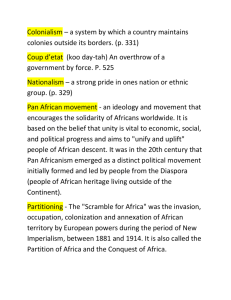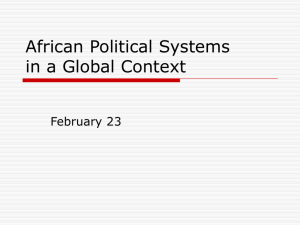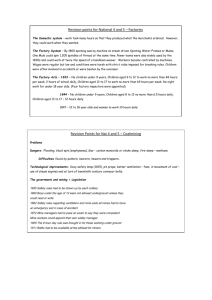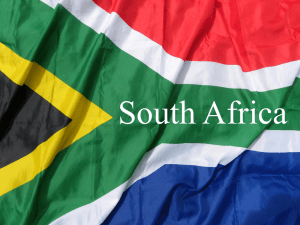South Africa
advertisement
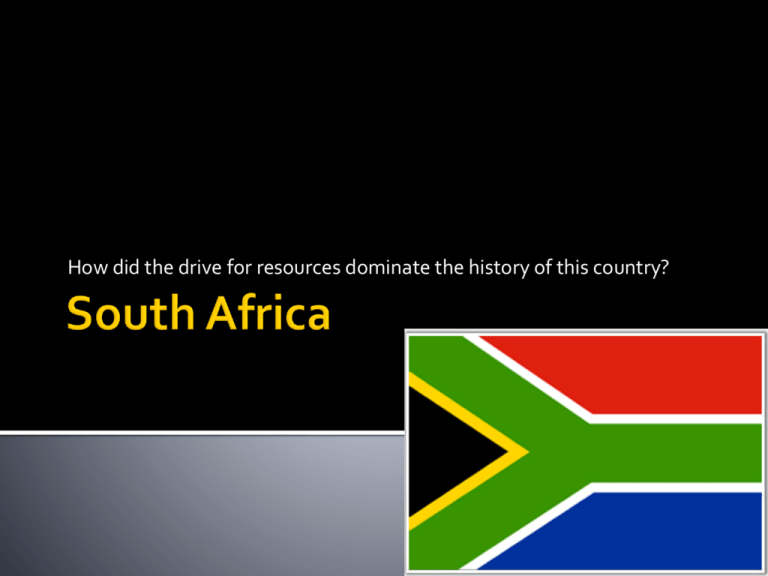
How did the drive for resources dominate the history of this country? Identify history of South Africa Evaluate effect of gold on South Africa’s economy and society Khoisan language groups Bantu language groups Migrated from central Africa Nguni Ancestors of the Zulu and Xhosa Portuguese Cape of Good Hope (1488) (1652) – Dutch East India Company French Huguenots refugees, the Dutch and Germans settled ▪ Afrikaners (1779)- Dutch authorities and the Xhosa fought first frontier war British gained control of the Cape of Good Hope by the end of the 18th century Afrikaner farmers – Boers Great northern migration to escape British rule Conflict with the Zulus Shaka (1787-1828) ▪ Conquered most of the territory ▪ Shaka assassinated replaced by half-brother Dingane ▪ Defeated by the Boers ▪ Zulus remained a formidable force ▪ Battle of Isandhlwana ▪ Finally conquered in 1879 1880-81 and 1899-1902 Discovery of gold and diamonds Influx of Europeans (mainly British) Many from neighboring areas moved to work in mines Mine owners ▪ Hostels Conflicts arose British prevailed 1910 – Union of South Africa 1910 British exerted their control over South African territories forming Union of South Africa Continued discrimination and segregation of Africans ▪ Prelude to Apartheid system ▪ Diminished rights of black majority Mines and Works Act of 1911 Limited black mine workers to menial labor ▪ Cheap Labor Native Lands Act of 1913 Divided land between blacks and whites 13% of land to blacks who made up majority ▪ Forced into wage work Why would the government want to force them into wage labor? Recession following WWI Mine owners reduced costs by hiring more black workers Resulted in Rand Rebellion -armed uprising of white mine workers Black labor needed in manufacturing industries Squatter camps sprung up among major white cities 1948 elections Nationalist Party victorious Policy of Apartheid Conflict arose South African Native National Congress & Pan African Congress 1959 Began demonstrations against laws Protesting banned Prominent leaders tried for treason ▪ Nelson Mandela ▪ Led the struggle to replace the apartheid regime with a multi-racial democracy ▪ Jailed for 27 years ▪ Country's first black president 1994-99 Government continued to ban new political parties and enforce apartheid legislation 1970’s South African Student Organization Black Consciousness Movement Black pride and non violent opposition Steve Biko May 1961 South Africa withdrew from the commonwealth 1984 – new constitution Allowed blacks and Asians a limited role in government All power remained in white hands Uprisings in 1967 and 1985 started to convince some members of the NP for the need for change 1984 P.W. Botha came to power Began movement to reform apartheid Some reforms but protests continued Government continued censorship of media and resistance to protestors 1986 -Secret discussion began between those members and Nelson Mandela 1989 – Mandela released from prison Unbanned the ANC and PAC 1991- the Group Areas Act, Land Acts and the Population Registration Act Last “pillars of apartheid” were abolished 1989 new president F.W. de Klerk Admitted apartheid a failure 1991 Convention for a Democratic South Africa Multiracial transitional government ▪ Equal rights ▪ Freedom of speech and religion ▪ Prohibited discrimination December 1993 – new interim constitution First nonracial elections were held on April 26-28, 1994 Nelson Mandela president on May 10, 1994 Established a Government of National Unity (GNU) Permanent constitution on May 9, 1996 Mandela signed it on December 10, 1997 and went into effect of February 3, 1997 Committed to reform Focused on social issues such as unemployment, housing shortages and crime Reintroduced South Africa into the global economy Stepped down in 1997 1999 – Thabo Mbeki Focused on bringing economic power to the black majority April 2004 – re-elected, “recalled” in 2007 2008 – Kgalema Motlante 2009 elections – Jacob Zuma New elections in 2012 Natural Resources such as Diamonds and Gold have been a major factor in South African economy The first Gold Rush in South Africa began in the late 1800’s Large amount found in 1886 Mining was a strong industry by 1887 Rand Mines New township of Johannesburg filled with settlers Archaean Witwatersrand Basin Main gold producing area Mined for more than 100 years Archaean greenstone belts Smaller gold producers 1899-1902 Two centuries of conflict British migrated to: Natal Then the Orange Free State and Transvaal Discovery of gold sparks the second war 1869- 21 –karat diamond found along the Orange River Kimberley diamond field Gold discovered near Johannesburg Boer leader – Stephanus Paul Kruger Cecil Rhodes – De Beers Consolidation Mine 1900- British had captured capitals of both Boer nations Afrikaners set up a guerrilla campaign British looted, razed villages and killed livestock Set up concentration camps for Boer women and children 20,000 died Surrendered May 1902 British now controlled all of South Africa Changed South Africa from an agricultural society to the largest gold-producer More than diamonds Gold Standard Gold discovered in 1886 Transvaal became the richest gold mining area in the world Langlaate becomes part of the big mining camp of Johannesburg Became the biggest town in Transvaal Prospectors Great hopes of “striking it rich” Laborers Young African men who came to pay; bride-price, taxes, guns or tools Others Made money off the needs of the people Improved roads then railways Joined the ports to the gold mines then to Kimberley New towns grew up around the stations Farmers also sent produce by train More people would now: Work for a wage Buy their clothes and food from a shop Lived in a compound, township or suburb Dig up the ground with picks and shovels Deep-level mining By 1906 the Robinson Deep Mine (Johannesburg) became the deepest mine in the world at 800 meters Pumps and ventilation Low-grade ore Had to crush up the ore to get to the gold All very labor intensive! Plentiful supply of cheap labor made gold mines in South Africa viable Most African farmers were not interested in working in the mines Once the African kingdoms were defeated government taxes and land control measures gave few options for survival Raised taxes so that a man had to work extra to meet the required tax Had to be paid in cash Had two choices: Earn money by selling produce or working for a short time on white farms or in town Or avoid paying the labor tax by working for wages for short periods either on farms or in towns Most chose to work in the mines because the wages were higher than farm work “Touts” – recruiters Paid by recruiting agencies for every worker they recruited Created a situation where there were more workers than jobs ▪ Low wages Governments cooperated with mines because they were major taxpayers AngloGold Ashanti is a leading global producer of gold Operations in South Africa at West Wits and Vaal River. Anglogold produced 4.98 million ounces of gold in 2008. Deep-level operations employ 37,000 people and produced 42% of the group’s production in 2008 Gold Fields is one of the world’s largest producers operations at Driefontein, Kloof, Beatrix and South Deep DRDGold is a medium-sizedgold producer 4th largest in South Africa. Half million South Africans rely on industry 40% of all gold One of World’s largest producers China surpassed South Africa in gold in 2007 Mines in South Africa are very deep Not surface mines-95% are underground operations ▪ depths of 3.8km Can be dangerous and expensive Coupled with declining grades, increased depth of mining and a slide in the gold price, costs have begun to rise Steady fall in production Highest cost is wages National Union of Mine Workers Better wages and working conditions
